Effects of Different Tillage Intensities on Physicochemical and Microbial Properties of a Eutric Fluvisol Soil
Abstract
:1. Introduction
2. Materials and Methods
2.1. Field Experiment Description and Soil Sampling
2.2. The Weather Conditions
2.3. Methods of Soil Analyses
2.3.1. Soil Physical Analyses
2.3.2. Soil Chemical Analyses
2.3.3. Soil Microbial Activity Analyses
2.3.4. Indices for Soil Quality Assessment
2.4. Statistical Analysis
3. Results and Discussion
3.1. Effects on Soil Stability
3.2. Effects on Soil Organic Carbon
3.3. Effects on Particulate Organic Matter Carbon
3.4. Effects on Hot-Water-Extractable Carbon and Nitrogen, and Cold-Water-Extractable Carbon and Nitrogen Fractions
3.5. Effects on Soil Basal Respiration
3.6. Effects on Microbial Biomass Carbon and Nitrogen
3.7. Effects on Soil Enzyme Activities
3.8. Effects on Potential Nitrification
3.9. Single Soil Quality Indices
3.9.1. Effects on Metabolic Quotient and Microbial Quotient
3.9.2. Effects on Enzymatic pH Level Indicator
3.9.3. Effects on Stratification Ratio for Soil Organic Carbon and Summarized Labile Carbon Fractions
3.9.4. Effects on Metabolic Potential Index
4. Conclusions
Author Contributions
Funding
Institutional Review Board Statement
Informed Consent Statement
Data Availability Statement
Acknowledgments
Conflicts of Interest
References
- Doran, J.W.; Sarrantonio, M.; Liebig, M. Soil health and sustainability. Adv. Agron. 1996, 56, 1–54. [Google Scholar] [CrossRef]
- Lal, R. Challenges and opportunities in soil organic matter research. Eur. J. Soil Sci. 2009, 60, 158–169. [Google Scholar] [CrossRef]
- Liebig, M.A.; Tanaka, D.L.; Wienhold, B.J. Tillage and cropping effects on soil quality indicators in the northern Great Plains. Soil Tillage Res. 2004, 78, 131–141. [Google Scholar] [CrossRef] [Green Version]
- Gajda, A.M.; Czyż, E.A.; Stanek-Tarkowska, J.; Dexter, A.R.; Furtak, K.M.; Grządziel, J. Effect of long-term tillage practices on the quality of soil under winter wheat. Plant Soil Environ. 2017, 63, 236–242. [Google Scholar] [CrossRef] [Green Version]
- Dexter, A.R. Soil physical quality. Part III: Unsaturated hydraulic conductivity and general conclusions about S-theory. Geoderma 2004, 120, 227–239. [Google Scholar] [CrossRef]
- Gajda, A.M.; Czyż, E.A.; Dexter, A.R.; Furtak, K.M.; Grządziel, J.; Stanek-Tarkowska, J. Effects of different soil management practices on soil properties and microbial diversity. Int. Agrophys. 2018, 32, 81–91. [Google Scholar] [CrossRef] [Green Version]
- Dexter, A.R.; Czyż, E.A.; Niedźwiecki, J. Water run-off as affected by the distributions of values of hydraulic conductivity of the soil. Ann. Rev. Agric. Eng. 2004, 3, 87–96. [Google Scholar]
- Gaţe, O.P.; Czyż, E.A.; Dexter, A.R. Soil physical quality, S, as a basis for relationships between key physical properties of arable soils. In Soil Management for Sustainability; Horn, R., Fleige, H., Peth, S., Peng, X., Eds.; Advances in GeoEcology; Catena Verlag: Reiskirchen, Germany, 2006; Volume 38, pp. 102–109. ISBN 978-3-510-65376-8. [Google Scholar]
- Czyż, E.A.; Dexter, A.R.; Terelak, H. Content of readily-dispersible clay in the arable layer of some Polish soils. In Sustainable Land Management-Environmental Protection. A Soil Physical Approach; Pagliai, M., Jones, R., Eds.; Advances in GeoEcology; Schweizerbart and Borntraeger Science Publishers: Stuttgart, Germany, 2002; Volume 35, pp. 115–124. [Google Scholar]
- Czyż, E.A.; Dexter, A.R. Soil physical properties under winter wheat grown with different tillage systems at selected locations. Int. Agrophys. 2008, 22, 191–201. [Google Scholar]
- Soane, B.D.; Ball, B.C.; Arvidsson, J.; Basch, G.; Moreno, F.; Roger-Estrade, J. No-till in northern, western and south-western Europe: A review of problems and opportunities for crop production and the environment. Soil Tillage Res. 2012, 118, 66–87. [Google Scholar] [CrossRef] [Green Version]
- Brennan, J.; Hackett, R.; McCabe, T.; Grant, J.; Fourtune, R.A.; Forristal, A.C. The effect of tillage system and residues management on grain yield and nitrogen use efficiency in winter wheat in cool Atlantic climate. Eur. J. Agron. 2014, 54, 61–69. [Google Scholar] [CrossRef]
- Cambardella, C.A.; Elliott, E.T. Particulate soil organic-matter changes across a grassland cultivation sequence. Soil Sci. Soc. Am. J. 1992, 56, 777–783. [Google Scholar] [CrossRef]
- Cambardella, C.A.; Gajda, A.M.; Doran, J.W.; Wienhold, B.J.; Kettler, T.A. Estimation of particulate and total organic matter by weight loss-on-ignition. In Assessment Methods for Soil Carbon; Lal, R., Kimble, J.M., Follett, R.F., Stewart, B.A., Eds.; CRC Press: Boca Raton, FL, USA, 2001; pp. 349–359. [Google Scholar]
- Gajda, A.M.; Czyż, E.A.; Ukalska-Jaruga, M. Comparison of the effects of different crop production systems on soil physico-chemical properties and microbial activity under winter wheat. Agronomy 2020, 10, 1130. [Google Scholar] [CrossRef]
- Gajda, A.M. Microbial activity and particulate organic matter content in soils with different tillage system use. Int. Agrophys. 2010, 24, 129–138. [Google Scholar]
- Stockdale, E.A.; Brookes, P.C. Detection and quantification of the soil microbial biomass impacts on the management of agricultural soils. J. Agric. Sci. 2006, 144, 285–302. [Google Scholar] [CrossRef]
- Andrade, D.S.; Colozzi-Filho, A.; Giller, K.E. The soil microbial community and soil tillage. In Soil Tillage in Agroecosystems; El Titi, A., Ed.; CRC Press: Boca Raton, FL, USA, 2003; pp. 51–81. Available online: https://www.taylorfrancis.com/books/9780429125850/chapters/10.1201/9781420040609-5 (accessed on 26 December 2002).
- Bandick, A.K.; Dick, P.P. Field management effects on soil enzyme activities. Soil Biol. Biochem. 1999, 31, 1471–1479. [Google Scholar] [CrossRef]
- Moreno, F.; Murillo, J.M.; Pelegrın, F.; Giron, I.F. Long-term impact of conservation tillage on stratification ratio of soil organic carbon and loss of total and active CaCO3. Soil Tillage Res. 2006, 85, 86–93. [Google Scholar] [CrossRef]
- Trivedi, P.; Delgado-Baquerizo, M.; Jeffries, T.C.; Trivedi, C.; Anderson, I.C.; Lai, K.; Minkey, D. Soil aggregation and associated microbial communities modify the impact of agricultural management on carbon content. Environ. Microbiol. 2017, 19, 3070–3086. [Google Scholar] [CrossRef]
- Tian, Q.; Taniguchi, T.; Shi, W.-Y.; Li, G.; Yamanaka, N.; Du, S. Land-use types and soil chemical properties influence soil microbial communities in the semiarid Loess Plateau region in China. Sci. Rep. 2017, 7, 45289. [Google Scholar] [CrossRef] [PubMed] [Green Version]
- Melero, S.; López-Garrido, R.; Murillo, J.M.; Moreno, F. Conservation tillage: Short-and long-term effects on soil carbon fractions and enzymatic activities under Mediterranean conditions. Soil Tillage Res. 2009, 104, 292–298. [Google Scholar] [CrossRef] [Green Version]
- Doni, S.; Macci, C.; Peruzzi, E.; Ceccanti, B.; Masciandaro, G. Factors Controlling Carbon Metabolism and Humification in Different Soil Agroecosystems. Sci. World J. 2014, 416074. [Google Scholar] [CrossRef] [PubMed] [Green Version]
- Balota, E.L.; Colozzi-Filho, A.; Andrade, D.S.; Dick, R.P. Microbial biomass in soils under different tillage and crop rotation systems. Biol. Fertil. Soils 2003, 38, 15–20. [Google Scholar] [CrossRef]
- Nannipieri, P.; Giagnoni, L.; Landi, L.; Renella, G. Role of Phosphatase Enzymes in Soil. In Phosphorus in Action, Soil Biology; Bunemann, E.K., Bünemann, E., Oberson, A., Frossard, E., Eds.; Springer: Berlin/Heidelberg, Germany, 2011; pp. 215–243. [Google Scholar] [CrossRef]
- Oprica, L.; Olteanu, Z.; Dunca, S.I.; Marius, S.; Zamfirache, M.M. The tillage effect on the soil acid and alkaline phosphatase activity. In Sectiunea Geneticasi Biologie Moleculara; Analele Stiintifice ale Universitatii Alexandru Ioan Cuza; Alexandru Ioan Cuza” University of Iași: Iaşi, Romania, 2011; Volume 12, pp. 103–110. Available online: https://www.researchgate.net/publication/237073526 (accessed on 9 June 2021).
- Piotrowska-Długosz, A.; Lemanowicz, J.; Długosz, J. The spatial pattern and seasonal changes in the soil phosphorus content in relation to the phosphatase activity: A case study of Luvisols. Arch. Agron. Soil Sci. 2020, 66, 1583–1597. [Google Scholar] [CrossRef]
- Bastida, F.; Zsolnay, A.; Hernández, T.; García, C. Past, present and future of soil quality indices: A biological perspective. Geoderma 2008, 147, 159–171. [Google Scholar] [CrossRef]
- Masciandaro, G.; Ceccanti, B.; Gallardo-Lancho, J.F. Organic matter properties in cultivated versus set-aside arable soils. Agric. Ecosyst. Environ. 1998, 67, 267–274. [Google Scholar] [CrossRef]
- Dick, W.A.; Cheng, L.; Wang, P. Soil acid and alkaline phosphatase activity as pH adjustment indicators. Soil Biol. Biochem. 2000, 32, 1915–1919. [Google Scholar] [CrossRef]
- Winding, A.; Hund-Rinke, K.; Rutgers, M. The use of microorganisms in ecological soil classification and assessment concepts. Ecotox. Environ. Saf. 2005, 62, 230–248. [Google Scholar] [CrossRef]
- Bongiorno, G.; Bünemann, E.K.; Oguejiofor, C.U.; Meier, J.; Gort, G.; Comans, R.; Mäder, P.; Brussaard, L.; de Goede, R. Sensitivity of labile carbon fractions to tillage and organic matter management and their potential as comprehensive soil quality indicators across pedoclimatic conditions in Europe. Ecol. Indic. 2019, 99, 38–50. [Google Scholar] [CrossRef]
- Polish Society of Soil Science, PTG. Particle size distribution and textural classes of soils and mineral materials—Classification of Polish Society of Soil Science (PTG in Polish). Soil Sci. Ann. 2009, 60, 5–16. [Google Scholar]
- IUSS Working Group WRB. World Reference Base for Soil Resources 2006, First Update 2007; World Soil Resources Reports No.103; FAO: Rome, Italy, 2007. [Google Scholar]
- Dexter, A.R.; Bird, N.R.A. Methods for predicting the optimum and the range of soil water contents for tillage based on the water retention curve. Soil Tillage Res. 2001, 57, 203–212. [Google Scholar] [CrossRef]
- Hack, H.; Bleiholder, H.; Buhr, L.; Meier, U.; Schnock-Fricke, U.; Weber, E.; Witzenberger, A. Einheitliche Codierung der phanologischen Entwicklungsstadien mono- und dikotyler Pflanzen—Erweiterte BBCH-Skala, Allgemein. Nachrichtenbl. Deut. Pflanzenschutzd. 1992, 44, 265–270. [Google Scholar]
- Howard, P.J.A. The carbon-organic matter factor in various soil types. Oikos 1965, 15, 229–236. [Google Scholar] [CrossRef]
- Ghani, A.; Dexter, M.; Perrott, K.W. Hot-water extractable carbon in soils: A sensitive measurement for determining impacts of fertilisation, grazing and cultivation. Soil Biol. Biochem. 2003, 35, 1231–1243. [Google Scholar] [CrossRef]
- ISO 16072. Soil Quality—Laboratory Methods for Determination of Microbial Soil Respiration; International Organization for Standardization: Geneva, Switzerland, 2002.
- PN-EN ISO 14240-2. Soil Quality—Laboratory Method for Determination of Microbial Biomass in Soil. Part 2: Fumigation—Extraction Method; Polish Committee for Standardization: Warsaw, Poland, 2011.
- Tabatabai, M.A.; Bremner, J.M. Use of p-nitrophenol phosphate for assay of soil phosphatases. Soil Biol. Biochem. 1969, 1, 301–307. [Google Scholar] [CrossRef]
- ISO 15685. Soil Quality—Determination of Potential Nitrification and Inhibition of Nitrification—Rapid Test. by Ammonium Oxidation; International Organization for Standardization: Geneva, Switzerland, 2012.
- Anderson, T.H.; Domsch, K.H. Application of eco-physiological quotients (qCO2 and qD) on microbial biomasses from soils of different cropping histories. Soil Biol. Biochem. 1990, 2, 251–255. [Google Scholar] [CrossRef]
- Anderson, T.H.; Domsch, K.H. Ratios of microbial biomass carbon to total organic-C in arable soils. Soil Biol. Biochem. 1989, 21, 471–479. [Google Scholar] [CrossRef]
- Franzluebbers, A.J. Soil organic matter stratification ratio as an indicator of soil quality. Soil Tillage Res. 2002, 66, 95–106. [Google Scholar] [CrossRef]
- Stanek-Tarkowska, J.; Czyż, E.A.; Dexter, A.; Sławiński, C. Effect of reduced and traditional tillage on soil properties and diversity of diatoms under winter wheat. Int. Agrophys. 2018, 32, 403–409. [Google Scholar] [CrossRef]
- Małecka, I.; Blecharczyk, A.; Sawińska, Z.; Swędrzyńska, D.; Piechota, T. Winter wheat yield and soil properties response to long-term non-inversion tillage. J. Agric. Sci. Technol. 2015, 17, 1571–1584. Available online: https://www.researchgate.net/publication/282847504 (accessed on 9 June 2021).
- Sarkar, I.; Khan, M.Z.; Hanif, M. Soil organic fractions in cultivated and uncultivated soils of Costal area in Bangladesh. J. Agric. Chem. Environ. 2019, 8, 129–144. [Google Scholar] [CrossRef] [Green Version]
- Guimarães, D.V.; Gonzaga, M.I.S.; Silva, T.O.; Silva, T.L.; Dias, N.; Matias, M.I. Soil organic matter pools and carbon fractions in soil under different land uses. Soil Tillage Res. 2013, 126, 177–182. [Google Scholar] [CrossRef] [Green Version]
- Awale, R.; Emerson, M.A.; Machado, S. Soil organic carbon pools as early indicators for soil organic matter stock changes under different tillage practices in Inland Pacific Northwest. Front. Ecol. Evol. 2017. [Google Scholar] [CrossRef] [Green Version]
- Curtin, D.; Wright, C.E.; Beare, M.H.; McCallum, F.M. Hot water-extractable nitrogen as an indicator of soil nitrogen availability. Soil Sci. Soc. Am. J. 2006, 70, 1512–1521. [Google Scholar] [CrossRef]
- Hamkalo, Z.; Bedernichek, T. Total, cold and hot water extractable organic carbon in soil profile: Impact of land-use change. Zemdirb. Agric. 2014, 101, 125–132. [Google Scholar] [CrossRef] [Green Version]
- Liu, E.; Teclemariam, S.G.; Yan, C.; Yu, J.; Gu, R.; Liu, S.; He, W.; Liu, Q. Long-term effects of no-tillage management practice on soil organic carbon and its fractions in the northern China. Geoderma 2014, 213, 379–384. [Google Scholar] [CrossRef]
- Martyniuk, S.; Koziel, M.; Stalenga, J.; Jończyk, K. Labile factions of soil organic matter and microbial characteristics of soil under organic and conventional crop management systems. Biol. Agric. Hortic. 2015, 32, 1–6. [Google Scholar] [CrossRef]
- Nielsen, M.N.; Winding, A. Microorganisms as Indicators of Soil Health; Technical Report 388; National Environmental Research Institute: Aarhus Universitet, Denmark, 2002; Available online: https://www.dmu.dk/1_viden/2_Publikationer/3_fagrapporter/rapporter/FR388.pdf (accessed on 9 June 2021).
- Cardoso, E.J.B.N.; Vascocellos, R.L.F.; Bini, D.; Miyauchi, M.Y.H.; dos Santos, C.A.; Alves, P.R.L.; de Paula, A.M.; Nakatani, A.S.; Pereira, J.M.; Nogueira, M.A. Soil health: Looking for suitable indicators. What should be considered to assess the effects of use and management on soil health? Sci. Agric. 2013, 274–289. [Google Scholar] [CrossRef] [Green Version]
- Saikia, R.; Sharma, S.; Thind, H.S.; Singh, Y. Tillage and residue management practices affect soil biological indicators in a rice-wheat cropping system in north-western India. Soil Use Manag. 2019, 36, 157–172. [Google Scholar] [CrossRef]
- Gajda, A.M.; Przewłoka, B.; Gawryjołek, K. Changes in soil quality associated with tillage system applied. Int. Agrophys. 2013, 27, 133–141. [Google Scholar] [CrossRef]
- Gajda, A.M.; Przewłoka, B. Soil biological activity as affected by tillage intensity. Int. Agrophys. 2012, 26, 15–23. [Google Scholar] [CrossRef]
- Jiang, X.; Wright, A.L.; Wang, J.; Li, Z. Long-term tillage effects on the distribution patterns of microbial biomass and activities within soil aggregates. Catena 2011, 87, 276–280. [Google Scholar] [CrossRef]
- Lamptey, S.; Li, L.; Xie, J.; Zhang, R.; Luo, Z.; Cai, L.; Liu, J. Soil respiration and net ecosystem production under different tillage practices in semi-arid Northwest China. Plant. Soil Environ. 2017, 63, 14–21. [Google Scholar]
- Aziz, I.; Mahmood, T.; Islam, K.R. Effect of long term no-till and conventional tillage practices on soil quality. Soil Tillage Res. 2013, 131, 28–35. [Google Scholar] [CrossRef]
- Hazarika, S.; Parkinson, R.; Bol, R.; Dixon, L.; Russell, P.; Donovan, S.; Allen, D. Effect of tillage system and straw management on organic matter dynamics. Agron. Sustain. Dev. 2009, 29, 525–533. [Google Scholar] [CrossRef]
- Merino, C.; Godoy, R.; Matus, F. Soil enzymes and biological activity at different levels of organic matter stability. J. Soil Sc. Plant. Nutr. 2016, 16, 14–30. [Google Scholar] [CrossRef] [Green Version]
- Wolińska, A.; Górniak, D.; Zielenkiewicz, U.; Goryluk-Salmonowicz, A.; Kuźniar, A.; Stępniewska, Z.; Błaszczyk, M. Microbial biodiversity in arable soils is affected by agricultural practices. Int. Agrophys 2017, 31, 259–271. [Google Scholar] [CrossRef] [Green Version]
- Błońska, E.; Lasota, J.; Zwydak, M. The relationship between soil properties, enzyme activity and land use. Leśne Prace Badaw. 2017, 78, 39–44. [Google Scholar] [CrossRef] [Green Version]
- Nyawade, S.O.; Karanja, N.N.; Gachene, C.K.K.; Harun, I.; Gitari, H.I.; Schulte-Geldermann, E.; Parker, M.L. Short-term dynamics of soil organic matter fractions and microbial activity in smallholder potato-legume intercropping systems. Appl. Soil Ecol. 2019, 142, 123–135. [Google Scholar] [CrossRef]
- Wittmann, C.; Kähkönen, M.A.; Ilvesniemi, H.; Kurola, J.; Salkinoja-Salonen, M.S. Areal activities and stratification of hydrolytic enzymes involved in the biochemical cycles of carbon, nitrogen, sulphur and phosphorus in podsolized boreal forest soils. Soil Biol. Biochem. 2004, 36, 425–433. [Google Scholar] [CrossRef]
- Mohammadi, K.; Heidari, G.; Karimi Nezhad, M.T.; Ghamari, S.; Sohrabi, Y. Contrasting soil microbial responses to fertilization and tillage systems in canola rhizosphere. Saudi J. Biol. Sci. 2012, 19, 377–383. [Google Scholar] [CrossRef] [Green Version]
- Wang, J.B.; Chen, Z.H.; Chen, L.J.; Zhu, A.N.; Wu, Z.J. Surface soil phosphorus and phosphatase activities affected by tillage and crop residue input amounts. Plant Soil Environ. 2011, 57, 251–257. [Google Scholar] [CrossRef] [Green Version]
- Cardoso, E.G.; de Moraes Sá, J.C.; Briedis, C.; de Oliveira Ferreira, A.; Borszowskei, P.R.; Santos, J.B.; Massinham, A.; Ferreira, C.F.; Siuta Júnior, D.; Baranek, E.J. Nitrogen dynamics in soil management systems. II—mineralization and nitrification rates. Rev. Bras. Ciência Solo 2011, 35, 1651–1660. [Google Scholar] [CrossRef] [Green Version]
- Li, S.; Jiang, X.; Wang, X.; Wright, A.L. Tollage effects on soil nitrification and the dynamic changes in nitrifying microorganisms in a subtropical rice-based ecosystem: A long-term field study. Soil Tillage Res. 2015, 150, 132–138. [Google Scholar] [CrossRef]
- Liu, X.; Shi, Y.; Zhang, Q.; Li, G. Effects of biochar on nitrification and denitrification-mediated N2O emissions and the associated microbial community in an agricultural soil. Environ. Sci. Poll. Res. 2021, 28, 6649–6663. [Google Scholar] [CrossRef] [PubMed]
- Mei, K.; Wang, Z.; Huang, H.; Zhang, C.; Shang, X.; Dahlgren, R.A.; Zhang, M.; Xia, F. Stimulation of N2O emission by conservation tillage management in agricultural lands: A meta-analysis. Soil Tillage Res. 2018, 182, 86–93. [Google Scholar] [CrossRef] [Green Version]
- Corrochano-Monsalve, M.; Huérfano, X.; Menéndez, S.; Torralbo, F.; Fuertes-Mendizábal, T.; Estavillo, J.-M.; González-Murua, C. Relationship between tillage management and DMPSA nitrification inhibitor efficiency. Sci Total Environ. 2020, 718, 134748. [Google Scholar] [CrossRef]
- Krauss, M.; Krause, H.-M.; Spangler, S.; Kandeler, E.; Behrens, S.; Kappler, A.; Mäder, P.; Gattinger, A. Tillage system affects fertilizer-induced nitrous oxide emissions. Biol. Fertil. Soils 2017, 53, 49–59. [Google Scholar] [CrossRef]
- Cao, Y.; Xu, L.; Zhang, Z.; Chen, Z.; He, N. Soil Microbial Metabolic Quotient in Inner Mongolian Grasslands: Patterns and Influence Factors. Chin. Geogr. Sci. 2019, 29, 1001–1010. [Google Scholar] [CrossRef] [Green Version]
- Zhou, H.; Zhang, D.; Wang, P.; Liu, X.; Cheng, K.; Li, L.; Zheng, J.; Zhang, X.; Zheng, J.; Crowley, D.; et al. Changes in microbial biomass and the metabolic quotient with biochar addition to agricultural soils: A meta-analysis. Agric. Ecosyst. Environ. 2017, 239, 80–89. [Google Scholar] [CrossRef] [Green Version]
- Xu, M.X.; Wang, Z.; Zhao, Y.G. Stratification ratio of soil organic carbon as an indicator of carbon sequestration and soil quality in ecological restoration. Restor. Ecol. 2018, 26, 555–562. [Google Scholar] [CrossRef]
- Yu, P.; Liu, S.; Ding, Z.; Zhang, A.; Tang, X. Changes in storage and the stratification ratio of soil organic carbon under different vegetation types in Northeastern China. Agronomy 2020, 10, 290. [Google Scholar] [CrossRef] [Green Version]
- Zhang, S.; Li, H.; Yang, X.; Sun, B. Effects of soil management regimes on biochemical properties of a loess soil. J. Soil Sci. Plant. Nutr. 2015, 15, 711–725. [Google Scholar] [CrossRef] [Green Version]
- Caravaca, F.; Masciandaro, G.; Ceccanti, B. Land use in relation to soil chemical and biochemical properties in a semiarid Mediterranean environment. Soil Tillage Res. 2002, 68, 23–30. [Google Scholar] [CrossRef]
- Monsalud, R.G.; Arguelles, E.D.L.R.; Brown, M.B.; Pedro, M.S.; Nepomuceno, R.A.; Villadiego, S.A.D.; Monsalud, F.C. Relationship between microbial soil quality indicators and soil productivity under cassava-based farming systems in various sites in the Philippines. J. ISSAAS 2021, 27, 87–105. Available online: https://www.researchgate.net/publication/352192391 (accessed on 9 June 2021).
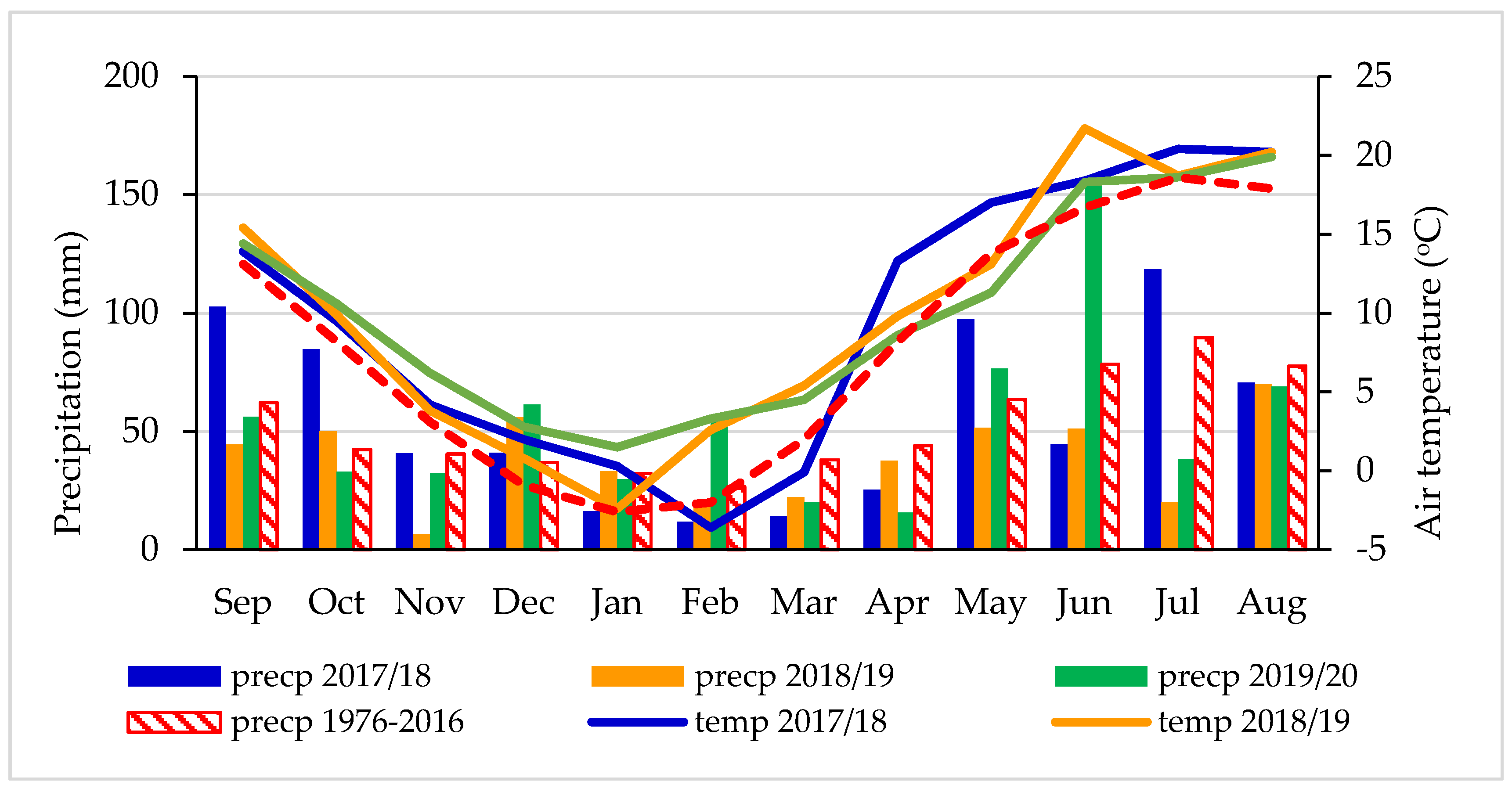
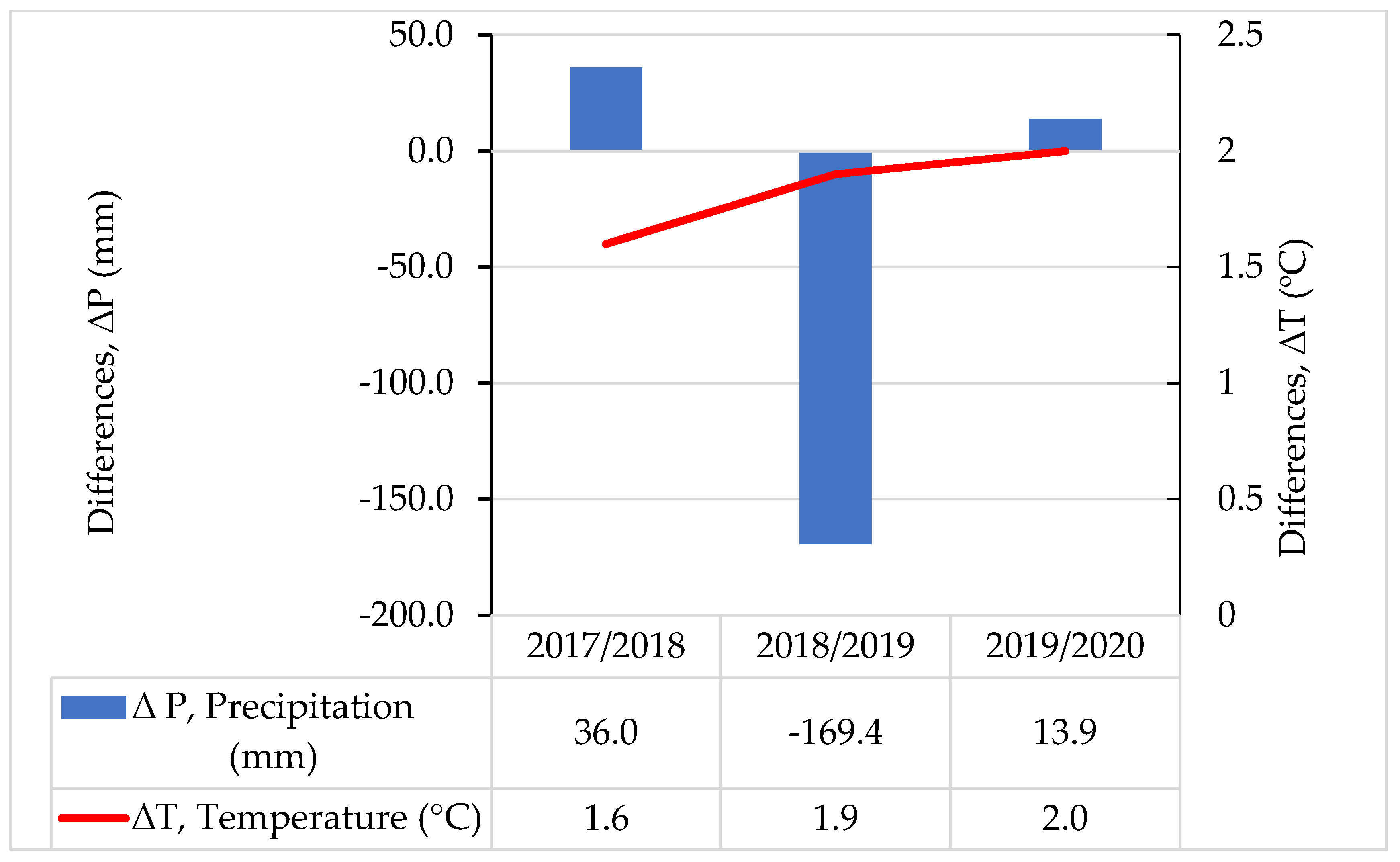
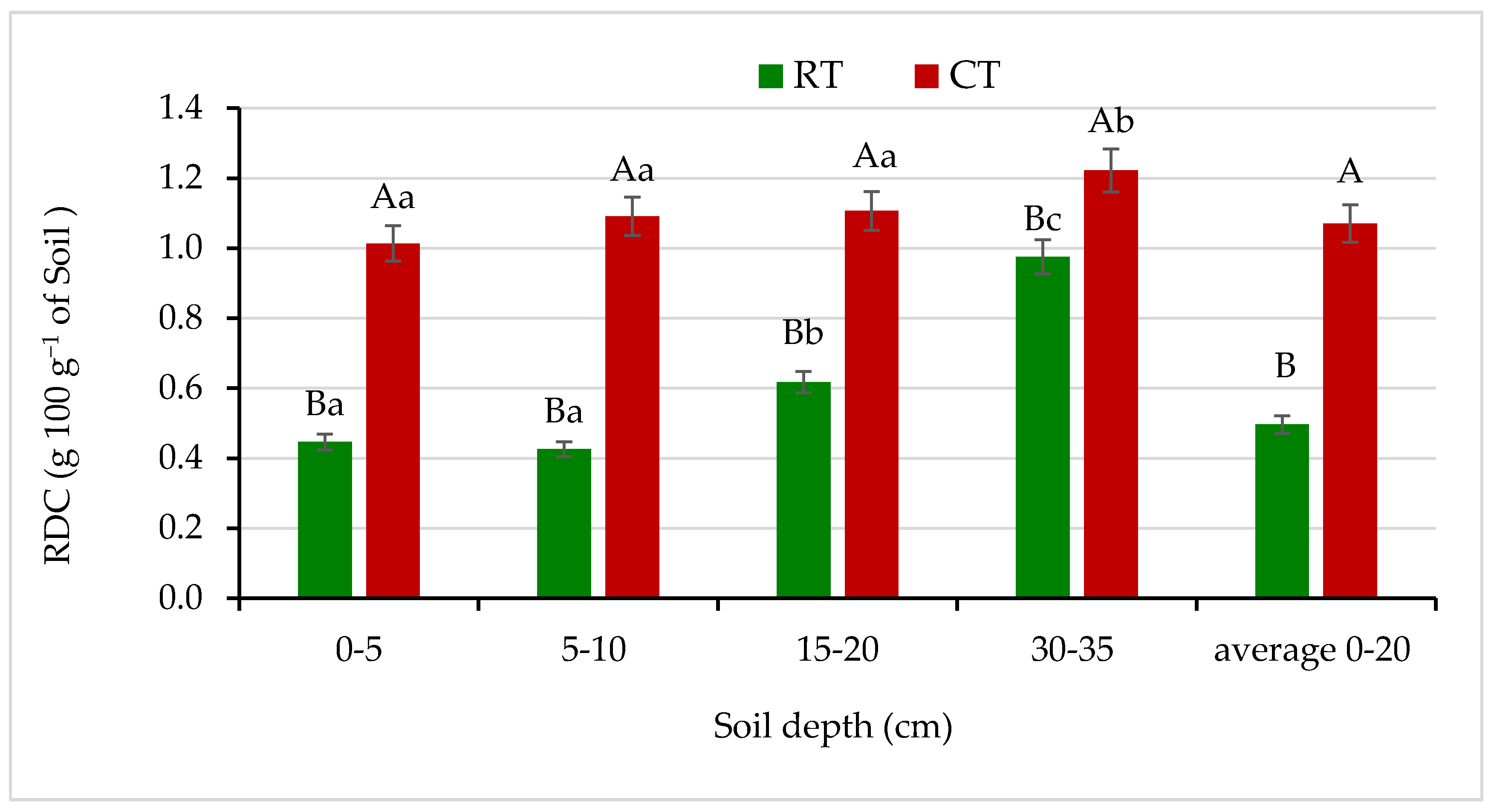
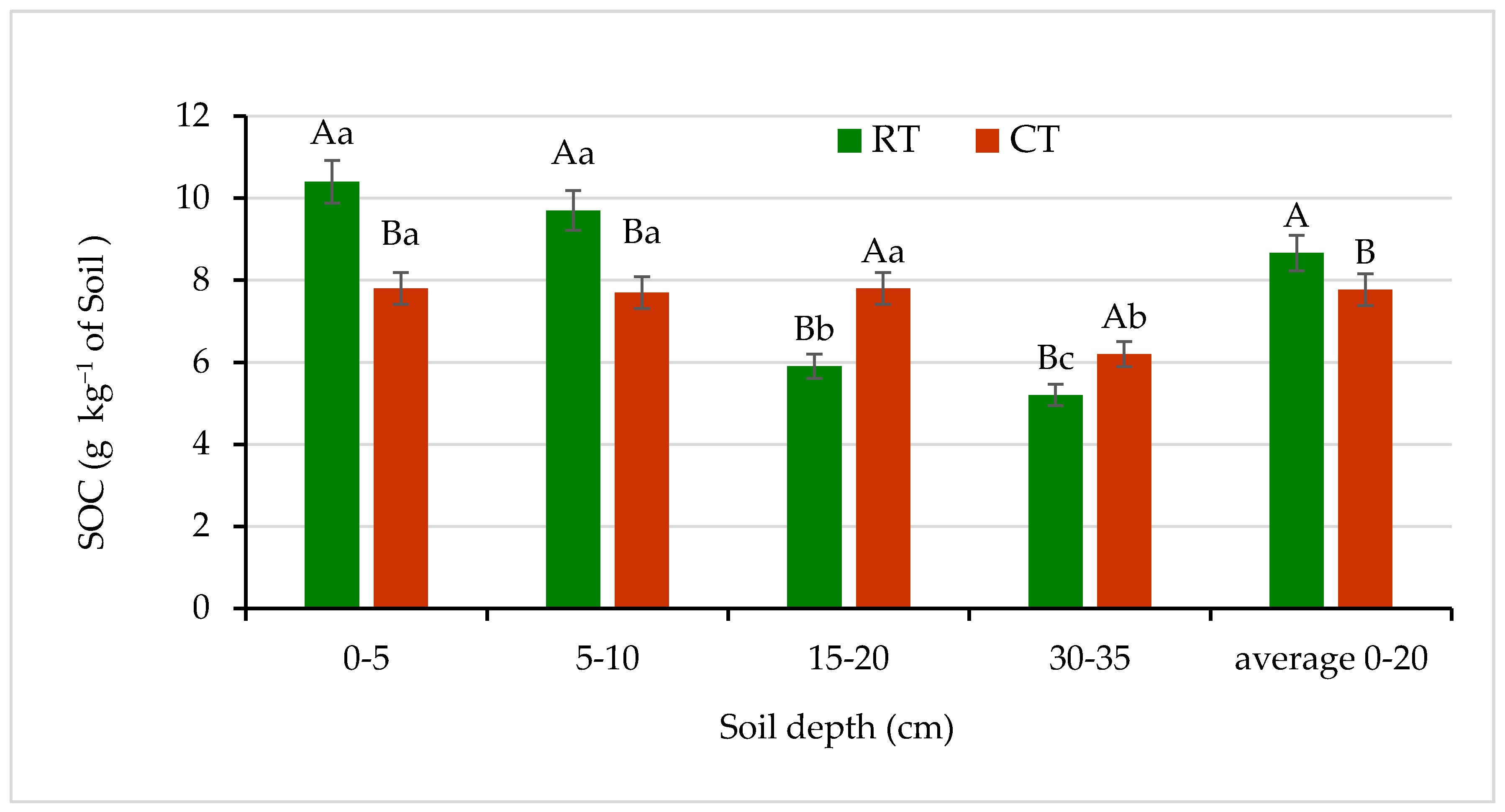
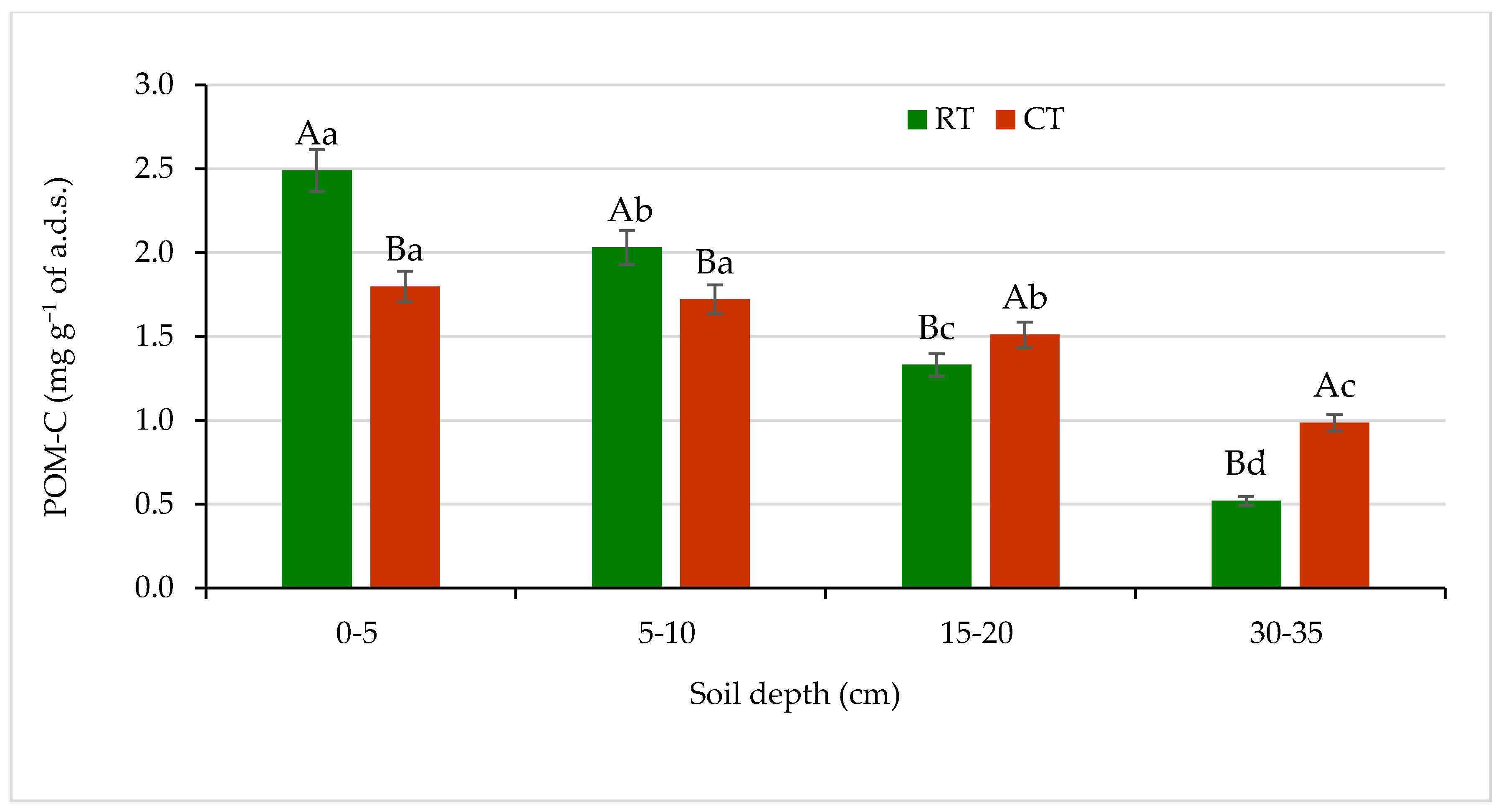
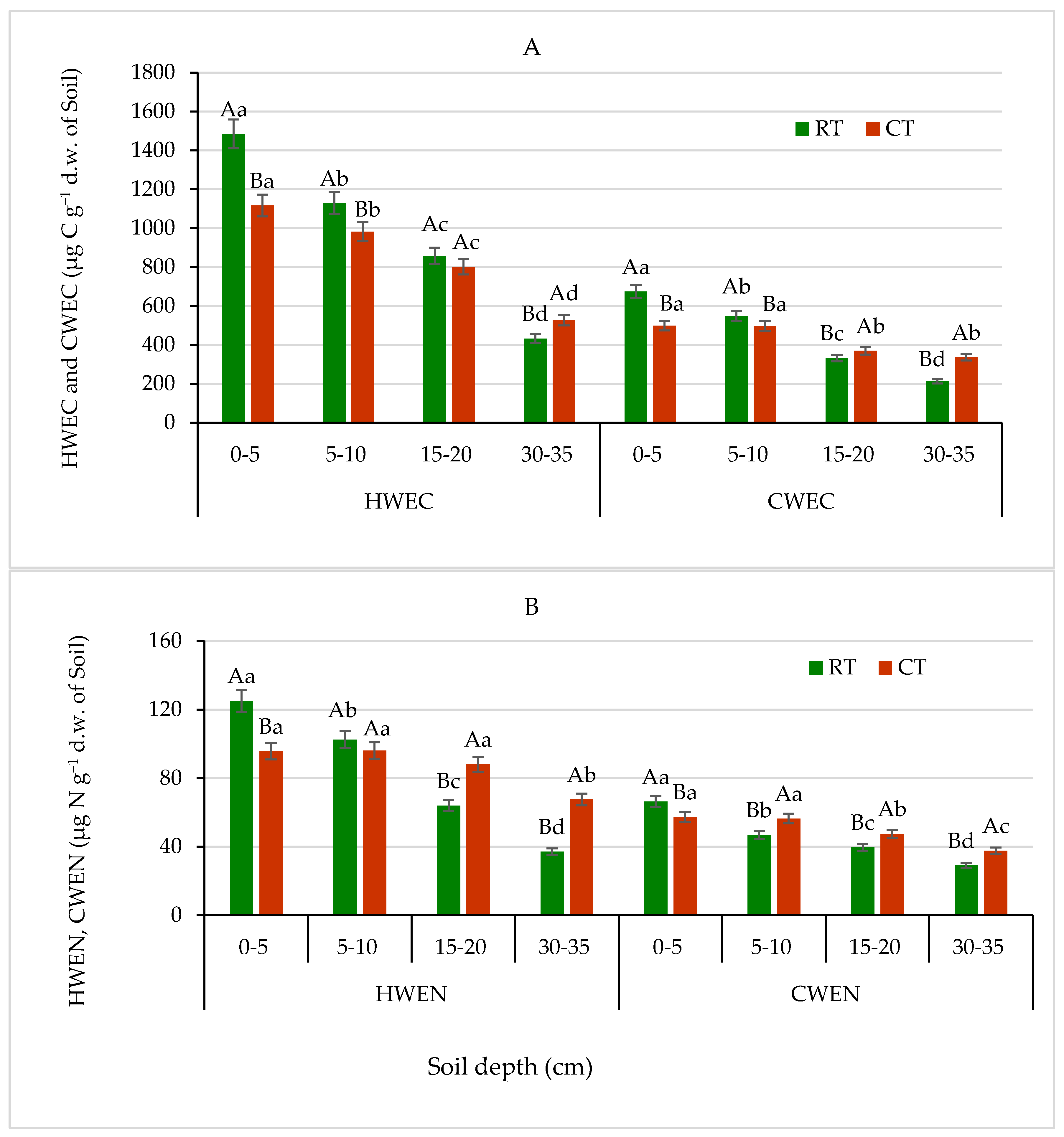
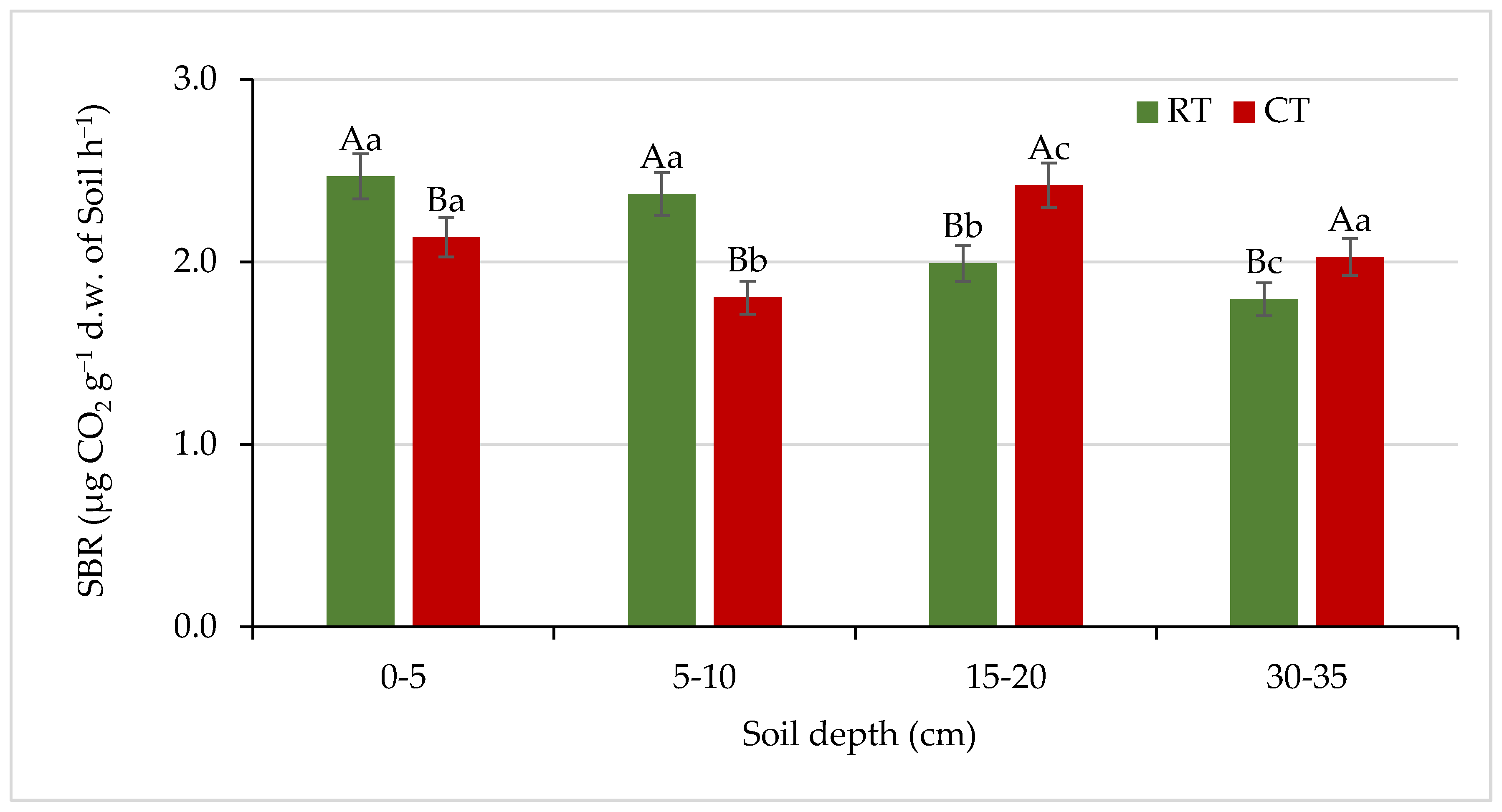

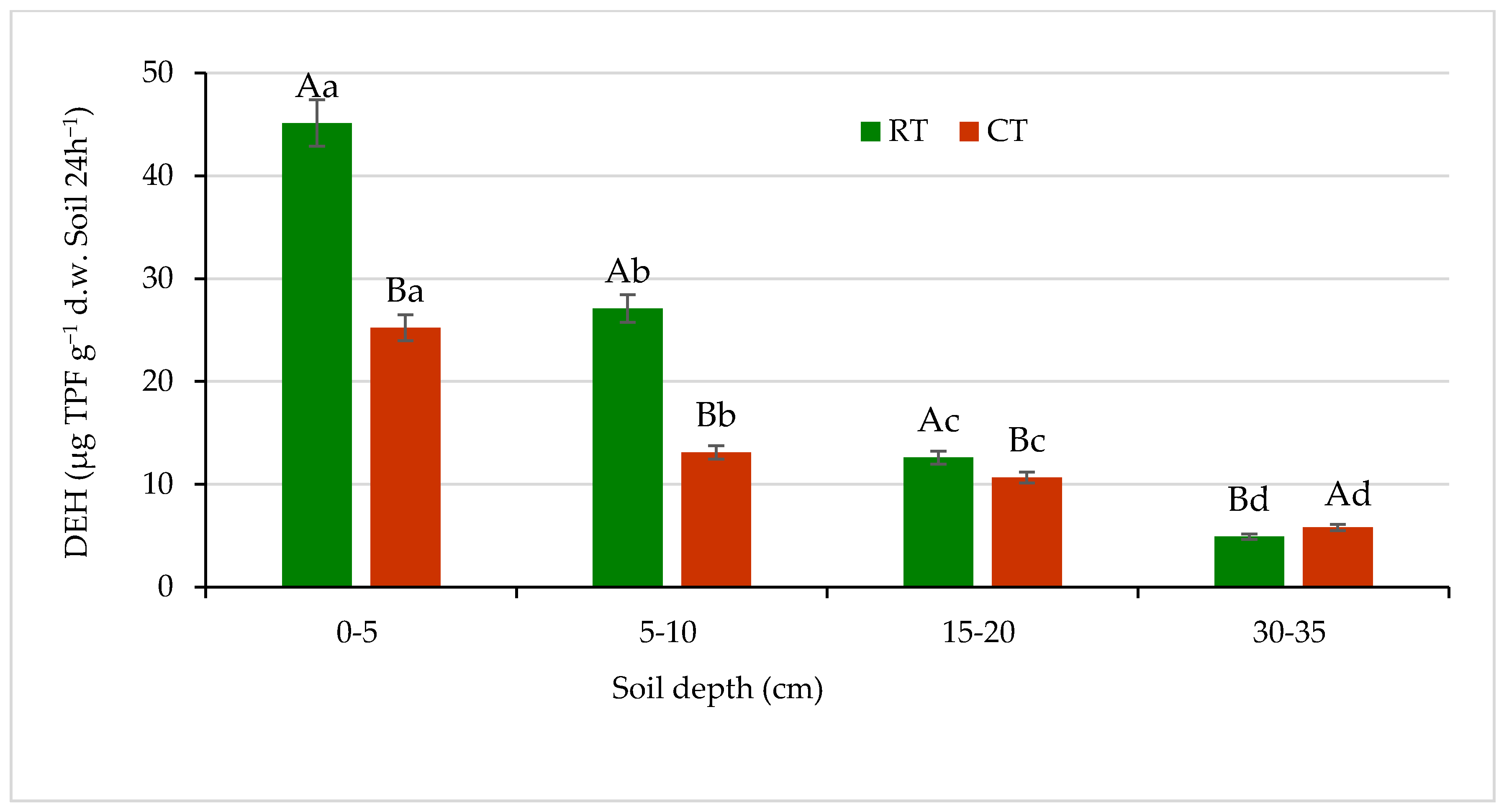
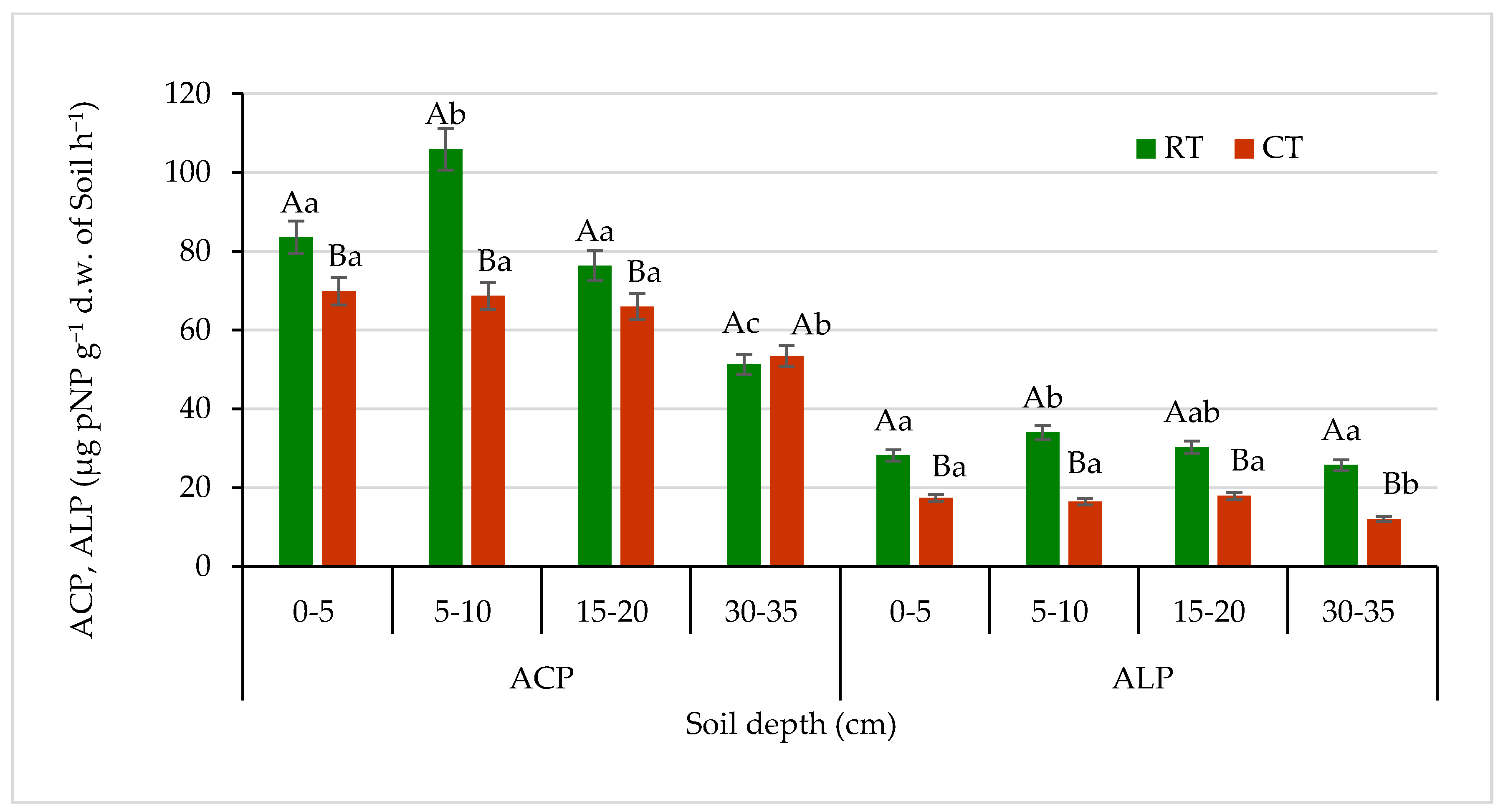

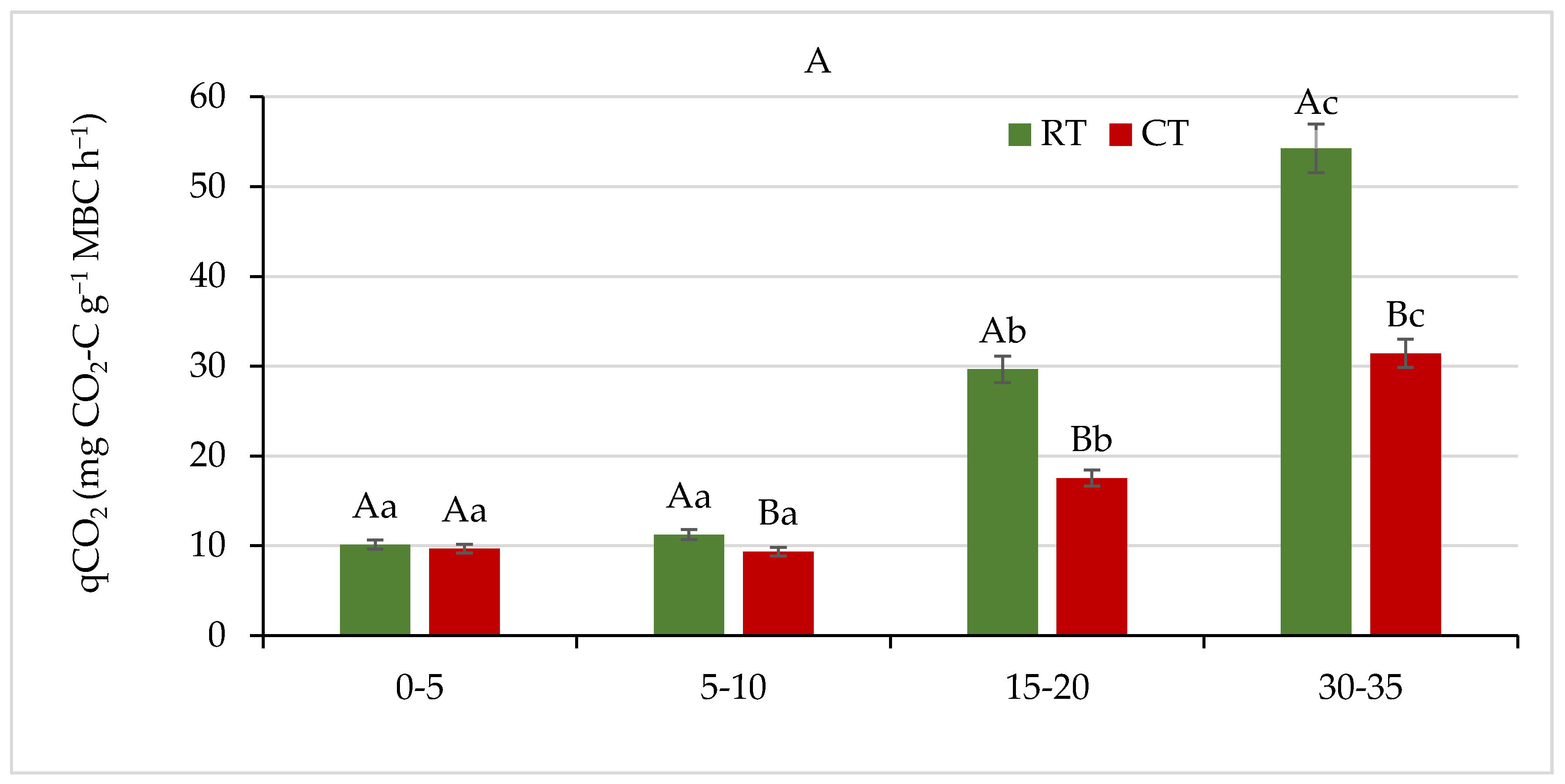
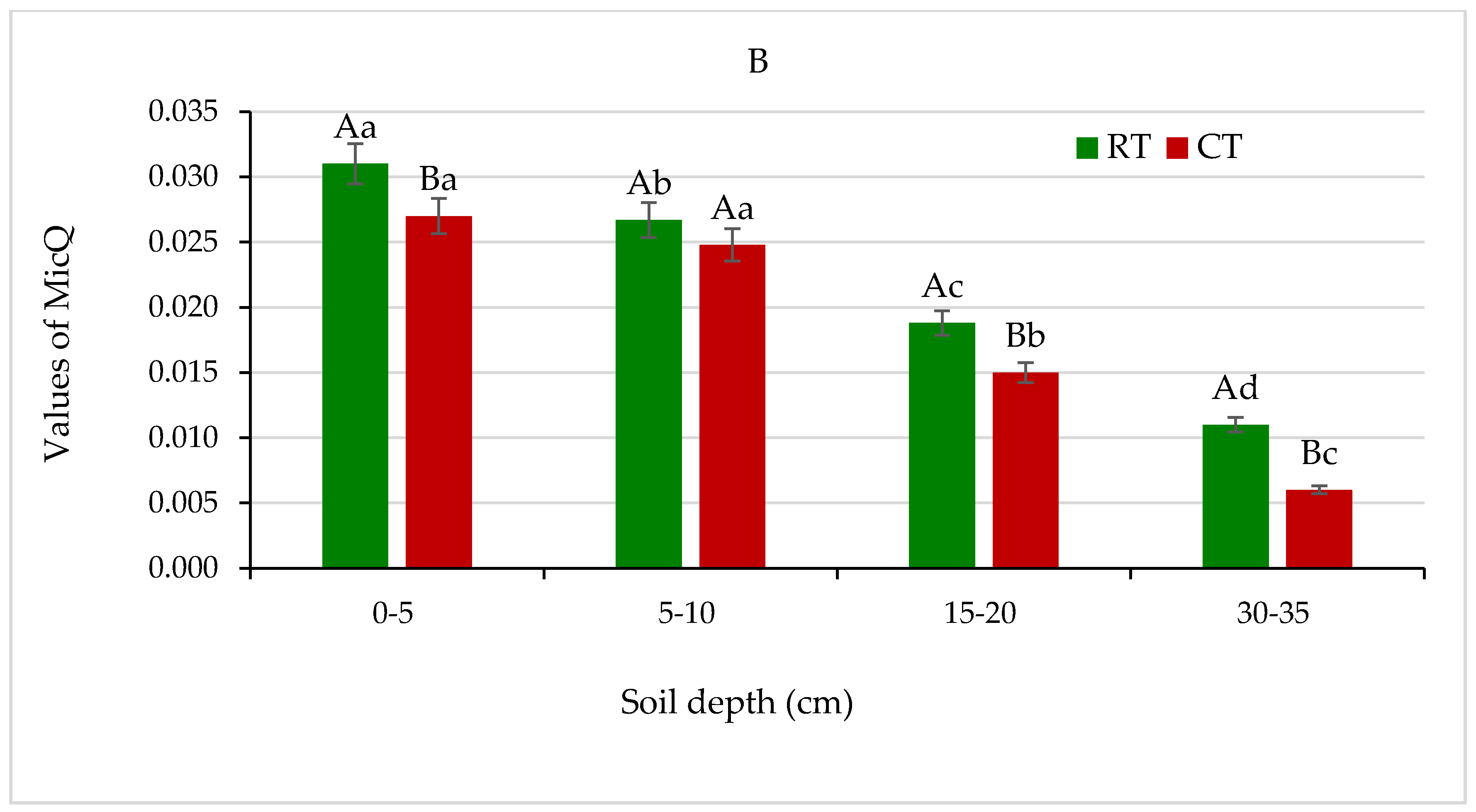

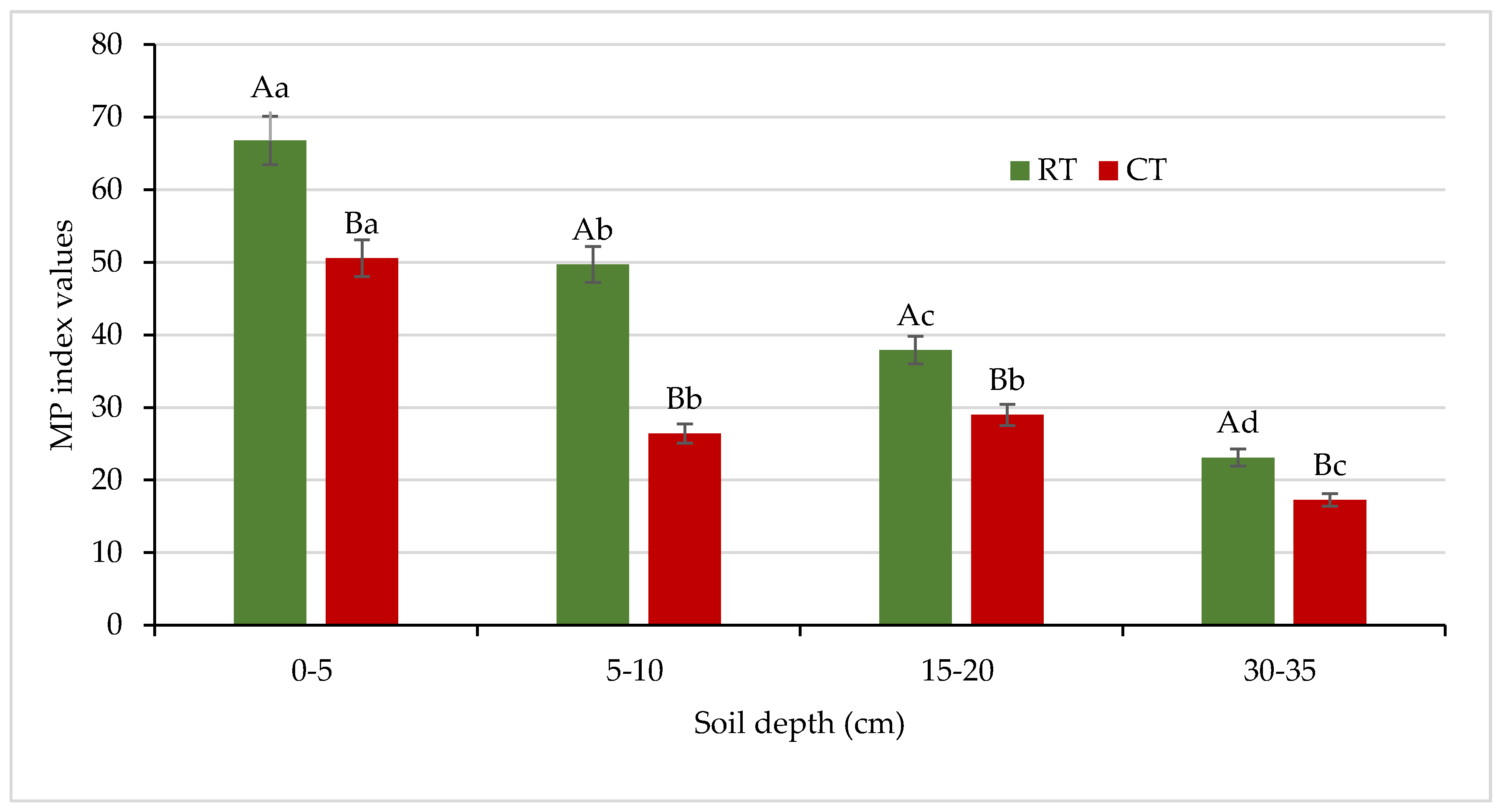
| Tillage System | Particle Size Distribution (%) | pH KCl | SOM | P | K | Mg | Nmin. | ||
|---|---|---|---|---|---|---|---|---|---|
| Sand | Silt | Clay | (g kg−1) | (mg kg−1) | (kg ha−1) | ||||
| RT | 71.6 | 25.9 | 2.5 | 6.4 A | 14.9 A | 172 B | 90 B | 88 A | 63.5 A |
| CT | 72.2 | 25.3 | 2.5 | 5.9 B | 13.4 B | 218 A | 105 A | 76 B | 47.7 B |
| HSD(0.05) | ns | ns | ns | 0.4 | 0.6 | 28.0 | 12.0 | 8.2 | 10.5 |
| Tillage System | RT | CT | ||||
|---|---|---|---|---|---|---|
| SR | SR1 | SR2 | SR3 | SR4 | SR5 | SR6 |
| Labile carbon | 1.23 Ad | 2.20 Ab | 5.12 Aa | 1.09 Be | 1.39 Bc | 2.27 Bb |
| SOC | 1.07 Ad | 1.76 Ab | 2.00 Aa | 1.01 Ad | 1.00 Bd | 1.26 Bc |
| Reduced Tillage System (n = 12) | |||||||||||||||
|---|---|---|---|---|---|---|---|---|---|---|---|---|---|---|---|
| Parameter | SOM | RDC | POM-C | HWEC | CWEC | MBC | HWEN | CWEN | MBN | SBR | DEH | ACP | ALP | NP | pH |
| SOM | 1.00 | −0.87 ** | 0.94 ** | 0.92 ** | 0.96 ** | 0.90 ** | 0.97 ** | 0.90 ** | 0.92 ** | 0.38 | 0.92 ** | 0.53 | 0.36 | 0.54 | 0.77 |
| RDC | 1.00 | −0.95 ** | −0.91 ** | −0.87 ** | −0.79 ** | −0.91 ** | −0.78 ** | −0.88 ** | −0.36 | −0.79 ** | −0.63 * | −0.55 | −0.53 | −0.62 * | |
| POM-C | 1.00 | 0.98 ** | 0.97 ** | 0.87 ** | 0.98 ** | 0.92 ** | 0.95 ** | 0.41 | 0.90 ** | 0.55 | 0.4 | 0.45 | 0.65 * | ||
| HWEC | 1.00 | 0.97 ** | 0.87 ** | 0.98 ** | 0.97 ** | 0.97 ** | 0.36 | 0.95 ** | 0.50 | 0.32 | 0.45 | 0.59 * | |||
| CWEC | 1.00 | 0.85 ** | 0.98 ** | 0.96 ** | 0.95 ** | 0.41 | 0.93 ** | 0.53 | 0.32 | 0.43 | 0.69 * | ||||
| MBC | 1.00 | 0.90 ** | 0.85 ** | 0.90 ** | 0.13 | 0.87 ** | 0.42 | 0.43 | 0.61 * | 0.69 * | |||||
| HWEN | 1.00 | 0.95 ** | 0.97 ** | 0.36 | 0.94 ** | 0.52 | 0.31 | 0.51 | 0.65 * | ||||||
| CWEN | 1.00 | 0.93 ** | 0.34 | 0.97 ** | 0.37 | 0.15 | 0.37 | 0.55 | |||||||
| MBN | 1.00 | 0.27 | 0.93 ** | 0.54 | 0.41 | 0.5 | 0.57 * | ||||||||
| SBR | 1.00 | 0.30 | 0.50 | 0.02 | −0.01 | 0.19 | |||||||||
| DEH | 1.00 | 0.35 | 0.18 | 0.46 | 0.56 * | ||||||||||
| ACP | 1.00 | 0.63 * | 0.66 * | 0.41 | |||||||||||
| ALP | 1.00 | 0.49 | 0.50 | ||||||||||||
| NP | 1.00 | 0.54 * | |||||||||||||
| pH | 1.00 | ||||||||||||||
| Conventional Tillage System (n = 12) | |||||||||||||||
| Parameter | SOM | RDC | POM-C | HWEC | CWEC | MBC | HWEN | CWEN | MBN | SBR | DEH | ACP | ALP | NP | pH |
| SOM | 1.00 | −0.86 ** | 0.87 ** | 0.82 ** | 0.65 * | 0.72 ** | 0.87 ** | 0.82 ** | 0.54 | 0.09 | 0.59 * | 0.44 | 0.89 ** | 0.55 | −0.12 |
| RDC | 1.00 | −0.93 ** | −0.96 ** | −0.83 ** | −0.82 ** | −0.88 ** | −0.87 ** | −0.78 ** | −0.04 | −0.86 ** | −0.51 | −0.83 ** | −0.65 * | 0.02 | |
| POM-C | 1.00 | 0.97 ** | 0.89 ** | 0.82 ** | 0.90 ** | 0.94 ** | 0.70* | 0.03 | 0.76 ** | 0.34 | 0.74 ** | 0.57 * | 0.04 | ||
| HWEC | 1.00 | 0.92 ** | 0.80 ** | 0.86 ** | 0.93 ** | 0.71 ** | −0.06 | 0.78 ** | 0.4 | 0.74 ** | 0.62 * | −0.01 | |||
| CWEC | 1.00 | 0.80 ** | 0.82 ** | 0.93 ** | 0.70* | −0.19 | 0.73 ** | 0.41 | 0.45 | 0.51 | 0.02 | ||||
| MBC | 1.00 | 0.80 ** | 0.82 ** | 0.81 ** | −0.21 | 0.82 ** | 0.54 | 0.58 * | 0.70 * | −0.09 | |||||
| HWEN | 1.00 | 0.93 ** | 0.75 ** | 0.06 | 0.71 ** | 0.61 ** | 0.76 * | 0.47 | 0.07 | ||||||
| CWEN | 1.00 | 0.65 * | −0.08 | 0.67 * | 0.46 | 0.65 * | 0.51 | 0.01 | |||||||
| MBN | 1.00 | −0.04 | 0.95 ** | 0.52 | 0.52 | 0.49 | 0.28 | ||||||||
| SBR | 1.00 | 0.04 | 0.12 | 0.18 | −0.43 | 0.34 | |||||||||
| DEH | 1.00 | 0.46 | 0.55 | 0.61 * | 0.12 | ||||||||||
| ACP | 1.00 | 0.44 | 0.13 | 0.01 | |||||||||||
| ALP | 1.00 | 0.51 | −0.001 | ||||||||||||
| NP | 1.00 | −0.59 * | |||||||||||||
| pH | 1.00 | ||||||||||||||
Publisher’s Note: MDPI stays neutral with regard to jurisdictional claims in published maps and institutional affiliations. |
© 2021 by the authors. Licensee MDPI, Basel, Switzerland. This article is an open access article distributed under the terms and conditions of the Creative Commons Attribution (CC BY) license (https://creativecommons.org/licenses/by/4.0/).
Share and Cite
Gajda, A.M.; Czyż, E.A.; Klimkowicz-Pawlas, A. Effects of Different Tillage Intensities on Physicochemical and Microbial Properties of a Eutric Fluvisol Soil. Agronomy 2021, 11, 1497. https://doi.org/10.3390/agronomy11081497
Gajda AM, Czyż EA, Klimkowicz-Pawlas A. Effects of Different Tillage Intensities on Physicochemical and Microbial Properties of a Eutric Fluvisol Soil. Agronomy. 2021; 11(8):1497. https://doi.org/10.3390/agronomy11081497
Chicago/Turabian StyleGajda, Anna Maria, Ewa Antonina Czyż, and Agnieszka Klimkowicz-Pawlas. 2021. "Effects of Different Tillage Intensities on Physicochemical and Microbial Properties of a Eutric Fluvisol Soil" Agronomy 11, no. 8: 1497. https://doi.org/10.3390/agronomy11081497





